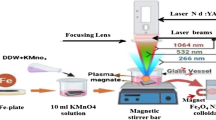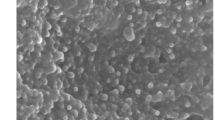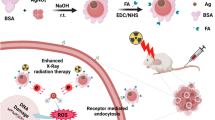Abstract
The use of nanotechnology in nanoparticle-based cancer therapeutics is gaining impetus due to the unique biophysical properties of nanoparticles at the quantum level. Silver nanoparticles (AgNPs) have been reported as one type of potent therapeutic nanoparticles. The present study is aimed to determine the effect of AgNPs in arresting the growth of a murine fibrosarcoma by a reductive mechanism. Initially, a bioavailability study showed that mouse serum albumin (MSA)-coated AgNPs have enhanced uptake; therefore, toxicity studies of AgNP-MSA at 10 different doses (1–10 mg/kg b.w.) were performed in LACA mice by measuring the complete blood count, lipid profile and histological parameters. The complete blood count, lipid profile and histological parameter results showed that the doses from 2 to 8 mg (IC50: 6.15 mg/kg b.w.) sequentially increased the count of leukocytes, lymphocytes and granulocytes, whereas the 9- and 10-mg doses showed conclusive toxicity. In an antitumor study, the incidence and size of fibrosarcoma were reduced or delayed when murine fibrosarcoma groups were treated by AgNP-MSA. Transmission electron micrographs showed that considerable uptake of AgNP-MSA by the sentinel immune cells associated with tumor tissue and a morphologically buckled structure of the immune cells containing AgNP-MSA. Because the toxicity studies revealed a relationship between AgNPs and immune function, the protumorigenic cytokines TNF-α, IL-6 and IL-1β were also assayed in AgNP-MSA-treated and non-treated fibrosarcoma groups, and these cytokines were found to be downregulated after treatment with AgNP-MSA.
This is a preview of subscription content, access via your institution
Access options
Subscribe to this journal
Receive 12 digital issues and online access to articles
$119.00 per year
only $9.92 per issue
Buy this article
- Purchase on Springer Link
- Instant access to full article PDF
Prices may be subject to local taxes which are calculated during checkout










Similar content being viewed by others
References
Keenan BP, Jaffee EM, Armstrong TD . Tumor immunology: multidisciplinary science driving basic and clinical advances . Cancer Immunol Res 2013 ; 1 : 16 –23 .
Zolnik BS, Gonzalez-Fernandez A, Sadrieh N, Dobrovolskaia MA . Nanoparticles and the immune system . Endocrinology 2010 ; 151 : 458 –465 .
Edwards-Jones V . The benefits of silver in hygiene, personal care and healthcare . Lett Appl Microbiol 2009 ; 49 : 147 –152 .
Chen X, Schluesener HJ . Nanosilver: a nanoproduct in medical application . Toxicol Lett 2008 ; 176 : 1 –12 .
Mukherjee S, Chowdhury D, Kotcherlakota R, Patra S, Vinothkumar B, Bhadra MP et al . Potential theranostics application of bio-synthesized silver nanoparticles (4-in-1 system) . Theranostics 2014 ; 4 : 316 –335 .
Jain J, Arora S, Rajwade JM, Omray P, Khandelwal S, Paknikar KM et al . Silver nanoparticles in therapeutics: development of an antimicrobial gel formulation for topical use . Mol Pharm 2009 ; 6 : 1388 –1401 .
Lee HY, Park HK, Lee YM, Kim K, Park SB . A practical procedure for producing silver nanocoated fabric and its antibacterial evaluation for biomedical applications . Chem Commun (Camb) 2007 ; 28 : 2959 –2961 .
Vigneshwaran N, Kathe AA, Varadarajan PV, Nachane RP, Balasubramanya RH . Functional finishing of cotton fabrics using silver nanoparticles . J Nanosci Nanotechnol 2007 ; 7 : 1893 –1897 .
Kokura S, Handa O, Takagi T, Ishikawa T, Naito Y, Yoshikawa T . Silver nanoparticles as a safe preservative for use in cosmetics . Nanomed Nanotechnol Biol Med 2010 ; 6 : 570 –574 .
Haase H, Fahmi A, Mahltig B . Impact of silver nanoparticles and silver ions on innate immune cells . J Biomed Nanotechnol 2014 ; 10 : 1146 –1156 .
Bhol KC, Schechter PJ . Topical nanocrystalline silver cream suppresses inflammatory cytokines and induces apoptosis of inflammatory cells in a murine model of allergic contact dermatitis . Br J Dermatol 2005 ; 152 : 1235 –1242 .
Gagne F, Auclair J, Fortier M, Bruneau A, Fournier M, Turcotte P et al . Bioavailability and immunotoxicity of silver nanoparticles to the freshwater mussel Elliptio complanata . J Toxicol Environ Health A 2013 ; 76 : 767 –777 .
Myrzakhanova M, Gambardella C, Falugi C, Gatti AM, Tagliafierro G, Ramoino P et al . Effects of nanosilver exposure on cholinesterase activities, CD41, and CDF/LIF-like expression in zebrafish (Danio rerio) larvae . BioMed Res Int 2013 ; 2013 : 12 .
Su CL, Chen TT, Chang CC, Chuang KJ, Wu CK, Liu WT et al . Comparative proteomics of inhaled silver nanoparticles in healthy and allergen provoked mice . Int J Nanomed 2013 ; 8 : 2783 –2799 .
de Jong WH, van der Ven LT, Sleijffers A, Park MV, Jansen EH, van Loveren H et al . Systemic and immunotoxicity of silver nanoparticles in an intravenous 28 days repeated dose toxicity study in rats . Biomaterials 2013 ; 34 : 8333 –8343 .
Liu H, Yang D, Yang H, Zhang H, Zhang W, Fang Y et al . Comparative study of respiratory tract immune toxicity induced by three sterilisation nanoparticles: silver, zinc oxide and titanium dioxide . J Hazard Mater 2013 ; 248–249 : 478 –486 .
Greulich C, Kittler S, Epple M, Muhr G, Koller M . Studies on the biocompatibility and the interaction of silver nanoparticles with human mesenchymal stem cells (hMSCs) . Langenbecks Arch Surg 2009 ; 394 : 495 –502 .
Lim DH, Jang J, Kim S, Kang T, Lee K, Choi IH . The effects of sub-lethal concentrations of silver nanoparticles on inflammatory and stress genes in human macrophages using cDNA microarray analysis . Biomaterials 2012 ; 33 : 4690 –4699 .
Tiwari DK, Jin T, Behari J . Dose-dependent in-vivo toxicity assessment of silver nanoparticle in Wistar rats . Toxicol Mech Methods 2011 ; 21 : 13 –24 .
Sriram MI, Kanth SB, Kalishwaralal K, Gurunathan S . Antitumor activity of silver nanoparticles in Dalton's lymphoma ascites tumor model . Int J Nanomedicine 2010 ; 5 : 753 –762 .
Maneewattanapinyo P, Banlunara W, Thammacharoen C, Ekgasit S, Kaewamatawong T . An evaluation of acute toxicity of colloidal silver nanoparticles . J Vet Med Sci 2011 ; 73 : 1417 –1423 .
Kim YS, Song MY, Park JD, Song KS, Ryu HR, Chung YH et al . Subchronic oral toxicity of silver nanoparticles . Part Fibre Toxicol 2010 ; 7 : 20 .
Park EJ, Bae E, Yi J, Kim Y, Choi K, Lee SH et al . Repeated-dose toxicity and inflammatory responses in mice by oral administration of silver nanoparticles . Environ Toxicol Pharmacol 2010 ; 30 : 162 –168 .
Xue Y, Zhang S, Huang Y, Zhang T, Liu X, Hu Y et al . Acute toxic effects and gender-related biokinetics of silver nanoparticles following an intravenous injection in mice . J Appl Toxicol 2012 ; 32 : 890 –899 .
Zhang T, Wang L, Chen Q, Chen C . Cytotoxic potential of silver nanoparticles . Yonsei Med J 2014 ; 55 : 283 –291 .
Gross L . Intradermal immunization of C3H mice against a sarcoma that originated in an animal of the same line . Cancer Res 1943 ; 3 : 326 –333 .
Foley EJ . Antigenic properties of methylcholanthrene-induced tumors in mice of the strain of origin . Cancer Res 1953 ; 13 : 835 –837 .
Noguchi Y, Jungbluth A, Richards EC, Old LJ . Effect of interleukin 12 on tumor induction by 3-methylcholanthrene . Proc Natl Acad Sci USA 1996 ; 93 : 11798 –11801 .
Devens BH, Lundak RL, Byus CV . Induction of murine fibrosarcomas by low dose treatment with 3-methylcholanthrene followed by promotion with 12-O-tetradecanoyl-phorbol-13-acetate . Cancer Lett 1984 ; 21 : 317 –324 .
Lee PC, Meisel D . Adsorption and surface-enhanced Raman of dyes on silver and gold sols . J Phys Chem 1982 ; 86 : 3391 –3395 .
Papadimitriou S, Bikiaris D, Avgoustakis K, Karavas E, Georgarakis M . Chitosan nanoparticles loaded with dorzolamide and pramipexole . Carbohydrate Polym 2008 ; 73 : 44 –54 .
Cavalieri EL, Rogan EG, Higginbotham S, Cremonesi P, Salmasi S . Tumor-initiating activity in mouse skin and carcinogenicity in rat mammary gland of dibenzo[a]pyrenes: the very potent environmental carcinogen dibenzo[a, l]pyrene . J Cancer Res Clin Oncol 1989 ; 115 : 67 –72 .
Choi HS, Kim JW, Cha YN, Kim C . A quantitative nitroblue tetrazolium assay for determining intracellular superoxide anion production in phagocytic cells . J Immunoassay Immunochem 2006 ; 27 : 31 –44 .
Sengupta M, Sharma GD, Chakraborty B . Effect of aqueous extract of Tinospora cordifolia on functions of peritoneal macrophages isolated from CCl4 intoxicated male albino mice . BMC Complement Altern Med 2011 ; 11 : 102 .
Chithrani BD, Chan WC . Elucidating the mechanism of cellular uptake and removal of protein-coated gold nanoparticles of different sizes and shapes . Nano Lett 2007 ; 7 : 1542 –1550 .
Kummitha CM, Malamas AS, Lu ZR . Albumin pre-coating enhances intracellular siRNA delivery of multifunctional amphiphile/siRNA nanoparticles . Int J Nanomed 2012 ; 7 : 5205 –5214 .
Cedervall T, Lynch I, Foy M, Berggård T, Donnelly SC, Cagney G et al . Detailed identification of plasma proteins adsorbed on copolymer nanoparticles . Angew Chem Int Ed Engl 2007 ; 46 : 5754 –5756 .
Lundqvist M, Sethson I, Jonsson BH . Protein adsorption onto silica nanoparticles: conformational changes depend on the particles' curvature and the protein stability . Langmuir 2004 ; 20 : 10639 –10647 .
Saptarshi S, Duschl A, Lopata A . Interaction of nanoparticles with proteins: relation to bio-reactivity of the nanoparticle . J Nanobiotechnol 2013 ; 11 : 26 .
Lundqvist M, Stigler J, Cedervall T, Berggård T, Flanagan MB, Lynch I et al . The evolution of the protein corona around nanoparticles: a test study . ACS Nano 2011 ; 5 : 7503 –7509 .
Lissoni P, Fumagalli L, Brivio F, Rovelli F, Messina G, Di Fede G et al . Cancer chemotherapy-induced lymphocytosis: a revolutionary discovery in the medical oncology . J Biol Regul Homeost Agents 2006 ; 20 : 29 –35 .
Liu X, Chen Y, Li H, Huang N, Jin Q, Ren K et al . Enhanced retention and cellular uptake of nanoparticles in tumors by controlling their aggregation behavior . ACS Nano 2013 ; 7 : 6244 –6257 .
Wang B, He X, Zhang Z, Zhao Y, Feng W . Metabolism of nanomaterials in vivo: blood circulation and organ clearance . Accounts Chem Res 2012 ; 46 : 761 –769 .
Figueras M, Busquets S, Carbó N, Almendro V, Argilés JM, López-Soriano FJ . Cancer cachexia results in an increase in TNF-alpha receptor gene expression in both skeletal muscle and adipose tissue . Int J Oncol 2005 ; 27 : 855 –860 .
Barton BE . IL-6-like cytokines and cancer cachexia: consequences of chronic inflammation . Immunol Res 2001 ; 23 : 41 –58 .
Ara T, Declerck YA . Interleukin-6 in bone metastasis and cancer progression . Eur J Cancer 2010 ; 46 : 1223 –1231 .
Balkwill F . TNF-alpha in promotion and progression of cancer . Cancer Metastasis Rev 2006 ; 25 : 409 –416 .
Casals E, Pfaller T, Duschl A, Oostingh GJ, Puntes V . Time evolution of the nanoparticle protein corona . ACS Nano 2010 ; 4 : 3623 –3632 .
Monopoli MP, Walczyk D, Campbell A, Elia G, Lynch I, Bombelli FB et al . Physical–chemical aspects of protein corona: relevance to in vitro and in vivo biological impacts of nanoparticles . J Am Chem Soc 2011 ; 133 : 2525 –2534 .
Gasser M, Rothen-Rutishauser B, Krug HF, Gehr P, Nelle M, Yan B et al . The adsorption of biomolecules to multi-walled carbon nanotubes is influenced by both pulmonary surfactant lipids and surface chemistry . J Nanobiotechnology 2010 ; 8 : 31 .
Ge C, Du J, Zhao L, Wang L, Liu Y, Li D et al . Binding of blood proteins to carbon nanotubes reduces cytotoxicity . Proc Natl Acad Sci USA 2011 ; 108 : 16968 –16973 .
Shiao SL, Ganesan AP, Rugo HS, Coussens LM . Immune microenvironments in solid tumors: new targets for therapy . Genes Dev 2011 ; 25 : 2559 –2572 .
Manke A, Wang L, Rojanasakul Y . Mechanisms of nanoparticle-induced oxidative stress and toxicity . BioMed Res Int 2013 ; 2013 : 15 .
Coussens LM, Werb Z . Inflammation and cancer . Nature 2002 ; 420 : 860 –867 .
AshaRani PV, Low Kah Mun G, Hande MP, Valiyaveettil S . Cytotoxicity and genotoxicity of silver nanoparticles in human cells . ACS Nano 2008 ; 3 : 279 –290 .
Park EJ, Yi J, Kim Y, Choi K, Park K . Silver nanoparticles induce cytotoxicity by a Trojan-horse type mechanism . Toxicol In Vitro 2010 ; 24 : 872 –878 .
Sumbayev VV, Yasinska IM, Garcia CP, Gilliland D, Lall GS, Gibbs BF et al . Gold nanoparticles downregulate interleukin-1beta-induced pro-inflammatory responses . Small 2013 ; 9 : 472 –477 .
Voronov E, Dotan S, Krelin Y, Song X, Elkabets M, Carmi Y et al . Unique versus redundant functions of IL-1alpha and IL-1beta in the tumor microenvironment . Front Immunol 2013 ; 4 : 177 .
Krelin Y, Voronov E, Dotan S, Elkabets M, Reich E, Fogel M et al . Interleukin-1beta-driven inflammation promotes the development and invasiveness of chemical carcinogen-induced tumors . Cancer Res 2007 ; 67 : 1062 –1071 .
Sheikpranbabu S, Kalishwaralal K, Venkataraman D, Eom SH, Park J, Gurunathan S . Silver nanoparticles inhibit VEGF- and IL-1beta-induced vascular permeability via Src dependent pathway in porcine retinal endothelial cells . J Nanobiotechnol 2009 ; 7 : 8 .
Acknowledgements
We gratefully acknowledge the following organizations and institutes for supporting the work.
1. Department of Biotechnology, Govt. of India for providing the DBT Research Associate fellowship to Dr Biswajit Chakraborty.
2. University Grant Commission, Government of India for providing a doctoral research fellowship to Ramkrishna Pal, Leichombam Mohindro Singh and Dewan Shahidur Rahman.
3. Sophisticated Analytical Instrument Facility, Indian Institute of Technology, Mumbai, India for analyzing the inductively coupled plasmon-atomic emission spectra.
4. Sophisticated Analytical Instrument Facility, North Eastern Hill University, Shillong, Meghalaya, India for TEM analysis.
5. Pasteur Institute, Shillong, Meghalaya, India for providing experimental animals.
Author information
Authors and Affiliations
Corresponding author
Additional information
Supplementary Information accompanies the paper on Cellular & Molecular Immunology’s website. (http://www.nature.com/cmi).
Supplementary information
Rights and permissions
About this article
Cite this article
Chakraborty, B., Pal, R., Ali, M. et al. Immunomodulatory properties of silver nanoparticles contribute to anticancer strategy for murine fibrosarcoma. Cell Mol Immunol 13, 191–205 (2016). https://doi.org/10.1038/cmi.2015.05
Received:
Revised:
Accepted:
Published:
Issue Date:
DOI: https://doi.org/10.1038/cmi.2015.05
Keywords
This article is cited by
-
Alteration in Inflammasome Cytokine Profile and Functional Plasticity of Macrophage Phenotype in Arsenic(0) Nanoparticle Treated Murine Fibrosarcoma
BioNanoScience (2022)
-
Advances in vaccine delivery systems against viral infectious diseases
Drug Delivery and Translational Research (2021)
-
In vitro study on the immunomodulatory effects of differently functionalized silver nanoparticles on human peripheral blood mononuclear cells
JBIC Journal of Biological Inorganic Chemistry (2021)
-
Synthesis and Characterization of Arsenic(III) Oxide Nanoparticles as Potent Inhibitors of MCF 7 Cell Proliferation through Proapoptotic Mechanism
BioNanoScience (2020)
-
Silver nanoparticles engineered by thermal co-reduction approach induces liver damage in Wistar rats: acute and sub-chronic toxicity analysis
3 Biotech (2019)



